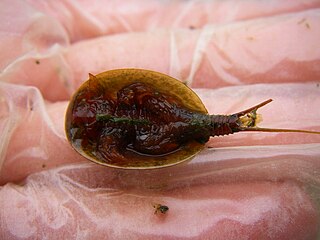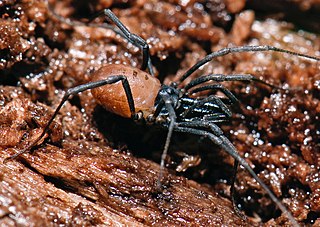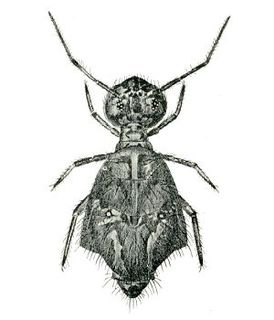
The Tortricidae are a family of moths, commonly known as tortrix moths or leafroller moths, in the order Lepidoptera. This large family has over 10,350 species described, and is the sole member of the superfamily Tortricoidea, although the genus Heliocosma is sometimes placed within this superfamily. Many of these are economically important pests. Olethreutidae is a junior synonym. The typical resting posture is with the wings folded back, producing a rather rounded profile.

Calathus is a genus of ground beetle native to the Palearctic, the Near East and North Africa. There are at least 190 described species in Calathus.

Lepidurus packardi, known by the common name vernal pool tadpole shrimp, is a rare species of tadpole shrimp (Notostraca).

Lepidurus is a genus of small crustaceans in the order Notostraca. It is the larger of the two extant genera of the tadpole shrimps, the other being Triops. They are commonly found in vernal pools and survive dry periods with the help of long lasting resting eggs.

Sabaconidae is a family of harvestmen with 57 described species in one genus, Sabacon, which is found throughout the Northern Hemisphere.

The Ceratolasmatidae are a family of harvestmen with eleven described species.

Great Valley Grasslands State Park is a state park of California, USA, preserving a parcel of remnant native grassland in the San Joaquin Valley. Such a temperate grasslands, savannas, and shrublands biome was once widespread throughout the whole Central Valley. The 2,826-acre (1,144 ha) park was established in 1982. Largely undeveloped, it was formed by combining two former state park units: San Luis Island and Fremont Ford State Recreation Area. Its chief attractions for visitors are spring wildflowers, fishing, and wildlife watching.

Allodesmus is an extinct genus of pinniped from the middle to late Miocene of California and Japan that belongs to the extinct pinniped family Desmatophocidae.
The World Register of Marine Species (WoRMS) is a taxonomic database that aims to provide an authoritative and comprehensive list of names of marine organisms.

Clivina is a genus of ground beetle native to the Palearctic, the Nearctic, the Near East and North Africa. There are at least 580 described species in Clivina.

Taracus is a genus of harvestman, or Opiliones, typically found living in caves in the United States. They grow to a size of 2.0–5.5 mm (0.08–0.22 in).

Cyclophora packardi, Packard's wave moth or Packard's wave, is a moth in the family Geometridae. It is found in North America, from Maine to Florida, west to Texas and north to Iowa and Ohio.

Schizopteridae is the largest family in the infraorder Dipsocoromorpha and comprises 56 genera and approximately 255 species. Schizopterids are some of the smallest (0.5–2.0 mm) true bugs. Members of this family can be distinguished by their small size, enlarged forecoxae and varying degree of abdominal and genitalic asymmetry in males. Schizopteridae exhibit a wide range of simple and complex wing venation patterns–some species even possess true elytra. The group is currently divided into three subfamilies: Schizopterinae, Ogeriinae and Hypselosomatinae.

Sminthurus is a genus of springtails described by Pierre André Latreille in 1802.
Metriocampa is a genus of two-pronged bristletails in the family Campodeidae. There are about six described species in Metriocampa.

Taracidae is a family of harvestmen in the order Opiliones. There are 4 genera and 23 described species in Taracidae.
Taracus pallipes is a species of harvestman in the family Taracidae found in North America.
Hesperonemastoma is a genus of harvestmen in the family Taracidae. There are about five described species in Hesperonemastoma.
Pseudanophthalmus packardi is a species of beetle found only in the Carter Caves of Kentucky. Individuals are blind and predatory, and remain close to underground streams in caves. They were first discovered in the X Cave in the late 1800s, but were mistaken for another species until Thomas C. Barr discovered its uniqueness in 1957.













